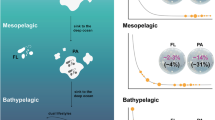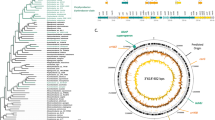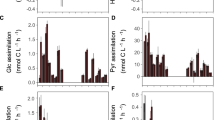Abstract
Photoheterotrophic microbes use organic substrates and light energy to satisfy their demand for carbon and energy and seem to be well adapted to eutrophic estuarine and oligotrophic oceanic environments. One type of photoheterotroph, aerobic anoxygenic phototrophic (AAP) bacteria, is especially abundant in particle-rich, turbid estuaries. To explore questions regarding the controls of these photoheterotrophic bacteria, we examined their abundance by epifluorescence microscopy, concentrations of the light-harvesting pigment, bacteriochlorophyll a (BChl a) and the diversity of pufM and 16S ribosomal RNA (rRNA) genes in the Chesapeake Bay. Concentrations of BChl a varied substantially, much more so than AAP bacterial abundance, along the estuarine salinity gradient. The BChl a concentration was correlated with turbidity only when oceanic and estuarine waters were considered together. Concentrations of BChl a and BChl a quotas were higher in particle-associated than in free-living AAP bacterial communities and appear to reflect physiological adaptation, not different AAP bacterial communities; pufM genes did not differ between particle-associated and free-living communities. In contrast, particle-associated and free-living bacterial communities were significantly different, on the basis of the analysis of 16S rRNA genes. The BChl a quota of AAP bacteria was not correlated with turbidity, suggesting that pigment synthesis varies in direct response to particles, not light attenuation. The AAP bacteria seem to synthesize more BChl a when dissolved and particulate substrates are available than when only dissolved materials are accessible, which has implications for understanding the impact of substrates on the level of photoheterotrophy compared with heterotrophy in AAP bacteria.
Similar content being viewed by others
Log in or create a free account to read this content
Gain free access to this article, as well as selected content from this journal and more on nature.com
or
Accession codes
References
Church MJ, Ducklow HW, Karl DA . (2004). Light dependence of 3H-leucine incorporation in the oligotrophic North Pacific Ocean. Appl Environ Microbiol 70: 4079–4087.
Cottrell MT, Kirchman DL . (2003). Contribution of major bacterial groups to bacterial biomass production (thymidine and leucine incorporation) in the Delaware estuary. Limnol Oceanogr 48: 168–178.
Cottrell MT, Kirchman DL . (2009). Photoheterotrophic microbes in the Arctic Ocean in summer and winter. Appl Environ Microbiol 75: 4958–4966.
Cottrell MT, Mannino A, Kirchman DL . (2006). Aerobic anoxygenic phototrophic bacteria in the Mid-Atlantic Bight and the North Pacific Gyre. Appl Environ Microbiol 72: 557–564.
Cottrell MT, Michelou VK, Nemcek N, DiTullio G, Kirchman DL . (2008). Carbon cycling by microbes influenced by light in the Northeast Atlantic Ocean. Aquat Microb Ecol 50: 239–250.
Crump BC, Armbrust EV, Baross JA . (1999). Phylogenetic analysis of particle-attached and free-living bacterial communities in the Columbia River, its estuary, and the adjacent coastal ocean. Appl Environ Microbiol 65: 3192–3204.
Crump BC, Peranteau C, Beckingham B, Cornwell JC . (2007). Respiratory succession and community succession of bacterioplankton in seasonally anoxic estuarine waters. Appl Environ Microbiol 73: 6802–6810.
Cullen JJ . (1982). The deep chlorophyll maximum—comparing vertical profiles of chlorophyll a. Can J Fish Aquat Sci 39: 791–803.
DeLong EF, Franks DG, Alldredge AL . (1993). Phylogenetic diversity of aggregate-attached vs free-living marine bacterial assemblages. Limnol Oceanogr 38: 924–934.
Eiler A . (2006). Evidence for the ubiquity of mixotrophic bacteria in the upper ocean: implications and consequences. Appl Environ Microbiol 72: 7431–7437.
Garneau ME, Vincent WF, Terrado R, Lovejoy C . (2009). Importance of particle-associated bacterial heterotrophy in a coastal Arctic ecosystem. J Mar Syst 75: 185–197.
Goericke R . (2002). Bacteriochlorophyll a in the ocean: is anoxygenic bacterial photosynthesis important? Limnol Oceanogr 47: 290–295.
Hammer Ø, Harper DAT, Ryan PD . (2001). Paleontological statistics software package for education and data analysis. Paleontol Electon 4: 9–17.
Kirchman DL, Yu LY, Fuchs BM, Amann R . (2001). Structure of bacterial communities in aquatic systems as revealed by filter PCR. Aquat Microb Ecol 26: 13–22.
Koblízek M, Béjà O, Bidigare RR, Christensen S, Benitez-Nelson B, Vetriani C et al. (2003). Isolation and characterization of Erythrobacter sp strains from the upper ocean. Arch Microbiol 180: 327–338.
Koblízek M, Masín M, Ras J, Poulton AJ, Prásil O . (2007). Rapid growth rates of aerobic anoxygenic phototrophs in the ocean. Environ Microbiol 9: 2401–2406.
Koblízek M, Stoñ-Egiert J, Sagan S, Kolber ZS . (2005). Diel changes in bacteriochlorophyll a concentration suggest rapid bacterioplankton cycling in the Baltic Sea. FEMS Microbiol Ecol 51: 353–361.
Kolber ZS, Plumley FG, Lang AS, Beatty JT, Blankenship RE, VanDover CL et al. (2001). Contribution of aerobic photoheterotrophic bacteria to the carbon cycle in the ocean. Science 292: 2492–2495.
Kolber ZS, Van Dover CL, Niederman RA, Falkowski PG . (2000). Bacterial photosynthesis in surface waters of the open ocean. Nature 407: 177–179.
Lami R, Cottrell MT, Ras J, Ulloa O, Obernosterer I, Claustre H et al. (2007). High abundances of aerobic anoxygenic photosynthetic bacteria in the South Pacific Ocean. Appl Environ Microbiol 73: 4198–4205.
Lami R, Cuperova Z, Ras J, Lebaron P, Koblizek M . (2009). Distribution of free-living and particle-attached aerobic anoxygenic phototrophic bacteria in marine environments. Aquat Microb Ecol 55: 31–38.
Li Q, Jiao NZ, Peng ZQ . (2006). Environmental control of growth and BChl a expression in an aerobic anoxygenic phototrophic bacterium, Erythrobacter longus (DSMZ6997). Acta Oceanol Sin 25: 138–144.
Lionard M, Muylaert K, Tackx M, Vyverman W . (2008). Evaluation of the performance of HPLC-CHEMTAX analysis for determining phytoplankton biomass and composition in a turbid estuary (Schelde, Belgium). Estuar Coast Shelf Sci 76: 809–817.
Mackey KRM, Rivlin T, Grossman AR, Post AF, Paytan A . (2009). Picophytoplankton responses to changing nutrient and light regimes during a bloom. Mar Biol 156: 1531–1546.
Mary I, Tarran GA, Warwick PE, Terry MJ, Scanlan DJ, Burkill PH et al. (2008). Light enhanced amino acid uptake by dominant bacterioplankton groups in surface waters of the Atlantic Ocean. FEMS Microbiol Ecol 63: 36–45.
Michelou VK, Cottrell MT, Kirchman DL . (2007). Light-stimulated bacterial production and amino acid assimilation by cyanobacteria and other microbes in the North Atlantic Ocean. Appl Environ Microbiol 73: 5539–5546.
Muyzer G, Dewaal EC, Uitterlinden AG . (1993). Profiling of complex microbial populations by denaturing gradient gel electrophoresis analysis of polymerase chain reaction-amplified gene coding for 16S ribosomal RNA. Appl Environ Microbiol 59: 695–700.
Parsons TR, Maita Y, Lalli CM . (1984). A Manual of Chemical and Biological Methods for Seawater Analysis, First edn. Pergamon Press: New York. xiv, 173 p.
Porter KG, Feig YS . (1980). The use of DAPI for identifying and counting aquatic microflora. Limnol Oceanogr 25: 943–948.
Ras J, Claustre H, Uitz J . (2008). Spatial variability of phytoplankton pigment distributions in the Subtropical South Pacific Ocean: comparison between in situ and predicted data. Biogeosciences 5: 353–369.
Rathgeber C, Lince MT, Alric J, Lang AS, Humphrey E, Blankenship RE et al. (2008). Vertical distribution and characterization of aerobic phototrophic bacteria at the Juan de Fuca Ridge in the Pacific Ocean. Photosyn Res 97: 235–244.
Salka I, Moulisová V, Koblížek M, Jost G, Jürgens K, Labrenz M . (2008). Abundance, depth distribution, and composition of aerobic bacteriochlorophyll a-producing bacteria in four basins of the central Baltic Sea. Appl Environ Microbiol 74: 4398–4404.
Schwalbach MS, Fuhrman JA . (2005). Wide-ranging abundances of aerobic anoxygenic phototrophic bacteria in the world ocean revealed by epifluorescence microscopy and quantitative PCR. Limnol Oceanogr 50: 620–628.
Sieracki ME, Gilg IC, Thier EC, Poulton NJ, Goericke R . (2006). Distribution of planktonic aerobic anoxygenic photoheterotrophic bacteria in the northwest Atlantic. Limnol Oceanogr 51: 38–46.
Stepanauskas R, Jorgensen NOG, Eigaard OR, Zvikas A, Tranvik LJ, Leonardson L . (2002). Summer inputs of riverine nutrients to the Baltic Sea: bioavailability and eutrophication relevance. Ecol Monogr 72: 579–597.
Veldhuis MJW, Kraay GW . (2004). Phytoplankton in the subtropical Atlantic Ocean: towards a better assessment of biomass and composition. Deep-Sea Res Part I Oceanogr Res Pap 51: 507–530.
Waidner LA, Kirchman DL . (2005). Aerobic anoxygenic photosynthesis genes and operons in uncultured bacteria in the Delaware River. Environ Microbiol 7: 1896–1908.
Waidner LA, Kirchman DL . (2007). Aerobic anoxygenic phototrophic bacteria attached to particles in turbid waters of the Delaware and Chesapeake Estuaries. Appl Environ Microbiol 73: 3936–3944.
Waidner LA, Kirchman DL . (2008). Diversity and distribution of ecotypes of the eerobic anoxygenic phototrophy gene pufM in the Delaware estuary. Appl Environ Microbiol 74: 4012–4021.
Yurkov VV, Beatty JT . (1998). Aerobic anoxygenic phototrophic bacteria. Microbiol Mol Biol Rev 62: 695–724.
Yutin N, Béjà O, Suzuki M . (2008). The use of denaturing gradient gel electrophoresis with fully degenerate pufM primers to monitor aerobic anoxygenic phototrophic assemblages. Limnol Oceanogr Meth 6: 427–440.
Yutin N, Suzuki MT, Béjà O . (2005). Novel primers reveal wider diversity among marine aerobic anoxygenic phototrophs. Appl Environ Microbiol 71: 8958–8962.
Yutin N, Suzuki MT, Teeling H, Weber M, Venter JC, Rusch DB et al. (2007). Assessing diversity and biogeography of aerobic anoxygenic phototrophic bacteria in surface waters of the Atlantic and Pacific Oceans using the Global Ocean Sampling expedition metagenomes. Environ Microbiol 9: 1464–1475.
Acknowledgements
We thank E Wommack for the opportunity to participate in a Chesapeake Bay cruise aboard the R/V Hugh R. Sharp. This study was supported by the US National Science Foundation grant MCB-0453993.
Author information
Authors and Affiliations
Corresponding author
Rights and permissions
About this article
Cite this article
Cottrell, M., Ras, J. & Kirchman, D. Bacteriochlorophyll and community structure of aerobic anoxygenic phototrophic bacteria in a particle-rich estuary. ISME J 4, 945–954 (2010). https://doi.org/10.1038/ismej.2010.13
Received:
Revised:
Accepted:
Published:
Issue date:
DOI: https://doi.org/10.1038/ismej.2010.13
Keywords
This article is cited by
-
Hydrodynamic impacts on tidal-scale dissolved inorganic nitrogen cycling and export across the estuarine turbidity maxima to coast
Biogeochemistry (2020)
-
Exploring the diversity and dynamic of bacterial community vertically distributed in Tongguling National Nature Reserve in Hainan Island, China
Brazilian Journal of Microbiology (2019)
-
Biogeographic patterns of aerobic anoxygenic phototrophic bacteria reveal an ecological consistency of phylogenetic clades in different oceanic biomes
Scientific Reports (2018)
-
Influence of selected environmental factors on the abundance of aerobic anoxygenic phototrophs in peat-bog lakes
Environmental Science and Pollution Research (2016)
-
Diversity of the aerobic anoxygenic phototrophy gene pufM in Arctic and Antarctic coastal seawaters
Acta Oceanologica Sinica (2016)



